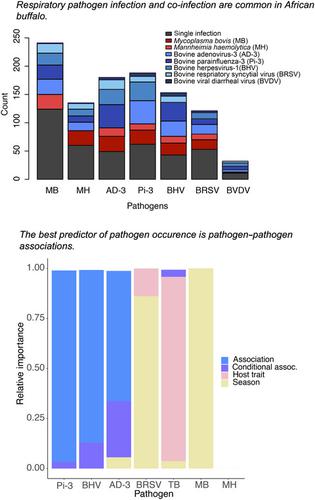当前位置:
X-MOL 学术
›
J. Anim. Ecol.
›
论文详情
Our official English website, www.x-mol.net, welcomes your feedback! (Note: you will need to create a separate account there.)
Co‐infection best predicts respiratory viral infection in a wild host
Journal of Animal Ecology ( IF 4.8 ) Pub Date : 2021-01-15 , DOI: 10.1111/1365-2656.13391 Caroline K. Glidden 1 , Courtney A. C. Coon 2 , Brianna R. Beechler 3 , Chase McNulty 3 , Vanessa O. Ezenwa 4 , Anna E. Jolles 1, 3
Journal of Animal Ecology ( IF 4.8 ) Pub Date : 2021-01-15 , DOI: 10.1111/1365-2656.13391 Caroline K. Glidden 1 , Courtney A. C. Coon 2 , Brianna R. Beechler 3 , Chase McNulty 3 , Vanessa O. Ezenwa 4 , Anna E. Jolles 1, 3
Affiliation

|
1) The dynamics of directly transmitted pathogens in natural populations are likely to result from the combined effects of host traits, pathogen biology and interactions among pathogens within a host. Discovering how these factors work in concert to shape variation in pathogen dynamics in natural host - multi-pathogen systems is fundamental to understanding population health. 2) Here, we describe temporal variation in incidence and then elucidate the effect of hosts trait, season, and pathogen co-occurrence on host infection risk using one of the most comprehensive studies of co-infection in a wild population: a suite of seven directly-transmitted, viral and bacterial, respiratory infections from a four-year study of 200 free-ranging African buffalo (Syncerus caffer). 3) Incidence of upper respiratory infections was common throughout the study - five out of the seven pathogens appeared to be consistently circulating throughout our study population. One pathogen exhibited clear outbreak dynamics in our final study year and another was rarely detected. 4) Co-infection was also common in this system. The strongest indicator of pathogen occurrence for respiratory viruses was, in fact, the presence of other viral respiratory infections. Host traits had minimal effects on odds of pathogen occurrence but did modify pathogen-pathogen associations. In contrast, only season predicted bacterial pathogen occurrence. 5) Though a combination of environmental, behavioral, and physiological factors work together to shape disease dynamics, we found pathogen associations best determined infection risk. Our study demonstrates that, in absence of very fine-scale data, the intricate changes among these factors are best represented by co-infection.
中文翻译:

混合感染最能预测野生宿主的呼吸道病毒感染
1) 自然种群中直接传播病原体的动态可能是宿主特征、病原体生物学和宿主内病原体之间相互作用的综合影响的结果。发现这些因素如何协同作用来塑造自然宿主中病原体动态的变化——多病原体系统是了解人口健康的基础。2) 在这里,我们描述了发病率的时间变化,然后使用最全面的野生种群共感染研究之一阐明宿主性状、季节和病原体共存对宿主感染风险的影响:一组七种对 200 头自由放养的非洲水牛 (Syncerus caffer) 进行的为期四年的研究中直接传播的病毒和细菌呼吸道感染。3) 在整个研究过程中上呼吸道感染的发生率很常见——七种病原体中有五种似乎在我们的研究人群中持续传播。在我们最后一年的研究中,一种病原体表现出明显的爆发动态,而另一种则很少被检测到。4) 在这个系统中,合并感染也很常见。事实上,呼吸道病毒病原体发生的最强指标是其他病毒性呼吸道感染的存在。宿主性状对病原体发生几率的影响很小,但确实改变了病原体-病原体的关联。相比之下,只有季节才能预测细菌病原体的发生。5) 虽然环境、行为和生理因素的组合共同作用于形成疾病动态,但我们发现病原体关联最能确定感染风险。
更新日期:2021-01-15
中文翻译:

混合感染最能预测野生宿主的呼吸道病毒感染
1) 自然种群中直接传播病原体的动态可能是宿主特征、病原体生物学和宿主内病原体之间相互作用的综合影响的结果。发现这些因素如何协同作用来塑造自然宿主中病原体动态的变化——多病原体系统是了解人口健康的基础。2) 在这里,我们描述了发病率的时间变化,然后使用最全面的野生种群共感染研究之一阐明宿主性状、季节和病原体共存对宿主感染风险的影响:一组七种对 200 头自由放养的非洲水牛 (Syncerus caffer) 进行的为期四年的研究中直接传播的病毒和细菌呼吸道感染。3) 在整个研究过程中上呼吸道感染的发生率很常见——七种病原体中有五种似乎在我们的研究人群中持续传播。在我们最后一年的研究中,一种病原体表现出明显的爆发动态,而另一种则很少被检测到。4) 在这个系统中,合并感染也很常见。事实上,呼吸道病毒病原体发生的最强指标是其他病毒性呼吸道感染的存在。宿主性状对病原体发生几率的影响很小,但确实改变了病原体-病原体的关联。相比之下,只有季节才能预测细菌病原体的发生。5) 虽然环境、行为和生理因素的组合共同作用于形成疾病动态,但我们发现病原体关联最能确定感染风险。


























 京公网安备 11010802027423号
京公网安备 11010802027423号